A) Gas station owners anticipate consumers will buy more gasoline as gasoline prices increase.
B) Gas station owners are attempting to repeal the laws of supply and demand.
C) Gas station owners anticipate higher replacement costs for their supply of gasoline and, therefore, raise their prices in response to this higher expected cost.
D) A decline in consumer demand generally causes gas station owners to raise their prices.
F) C) and D)
Correct Answer

verified
Correct Answer
verified
Multiple Choice
Isabella buys a new camera for $80. She receives consumer surplus of $35 on her purchase if her willingness to pay is
A) $35.
B) $45.
C) $80.
D) $115.
F) A) and B)
Correct Answer

verified
Correct Answer
verified
Multiple Choice
How would a decrease in consumer income affect the market for lawn mowers?
A) Demand would decrease, leading to an increase in price and a reduction in quantity sold.
B) Demand would decrease, leading to a reduction in price and a reduction in quantity sold.
C) Demand would increase, leading to an increase in price and an increase in quantity sold.
D) Demand would increase, leading to a reduction in price and an increase in quantity sold.
F) B) and C)
Correct Answer

verified
Correct Answer
verified
Multiple Choice
If the demand for a good increased, what would be the effect on the equilibrium price and quantity?
A) Price would increase, and quantity would decrease.
B) Price would decrease, and quantity would decrease.
C) Price would increase, and quantity would increase.
D) Price would decrease, and quantity would increase.
F) C) and D)
Correct Answer

verified
Correct Answer
verified
Multiple Choice
Which of the following would increase the supply of laptop computers?
A) higher wage rates for the workers that produce laptop computers
B) a technological improvement that lowers the cost of producing laptop computers
C) an increase in the price of computer chips used to produce laptop computers
D) all of the above
F) A) and C)
Correct Answer

verified
Correct Answer
verified
Multiple Choice
Which of the following about demand is true?
A) The height of the demand curve for a product at a given quantity represents the marginal value derived by the consumption of that unit.
B) The height of the demand curve for a product at a given quantity reflects the total value consumers derive from all units of the good consumed.
C) The total area above the demand curve for a product is equal to consumer surplus.
D) At every quantity, the height of the demand curve for a product represents the cost of producing that unit.
F) A) and C)
Correct Answer

verified
Correct Answer
verified
Multiple Choice
Which of the following most accurately describes the invisible hand concept?
A) Wise central planning by government is necessary for the efficient use of resources.
B) In a democratic setting, majority rule will result in the efficient use of resources.
C) In a market setting, when individuals pursue their own interests, they simultaneously tend to promote the public interest.
D) In a market setting, when individuals pursue their own interests, they tend to engage in activities that lower the overall economic welfare of society.
F) B) and D)
Correct Answer

verified
Correct Answer
verified
Multiple Choice
Figure 3-20 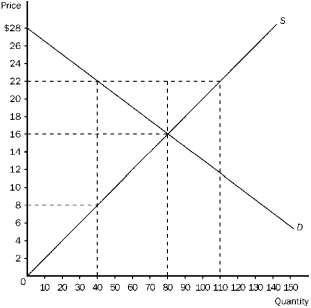 -Refer to Figure 3-20. If 40 units of the good are being bought and sold, then
-Refer to Figure 3-20. If 40 units of the good are being bought and sold, then
A) cost to sellers is equal to the value to buyers.
B) the value to buyers is greater than the cost to sellers.
C) the cost to sellers is greater than the value to buyers.
D) producer surplus would be greater than consumer surplus.
F) All of the above
Correct Answer

verified
Correct Answer
verified
Multiple Choice
If the quantity of a good supplied is not very sensitive to the price of the good, economists say the supply of the good is relatively
A) inelastic.
B) elastic.
C) robust.
D) inverse.
F) B) and C)
Correct Answer

verified
Correct Answer
verified
Multiple Choice
Figure 3-22 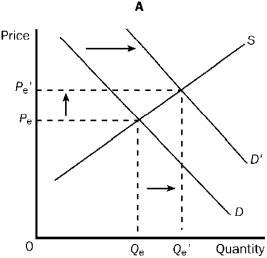

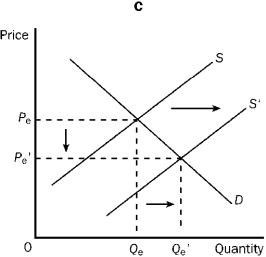
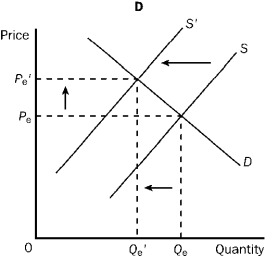 -Refer to Figure 3-22. Graph C shows which of the following?
-Refer to Figure 3-22. Graph C shows which of the following?
A) An increase in demand and an increase in quantity supplied.
B) An increase in demand and an increase in supply.
C) An increase in quantity demanded and an increase in quantity supplied.
D) An increase in supply and an increase in quantity demanded.
F) A) and C)
Correct Answer

verified
Correct Answer
verified
Multiple Choice
Which one of the following factors would increase the demand for oranges?
A) an increase in the price of grapefruit, a substitute product
B) a reduction in the price of bananas, a substitute product
C) development of a line of high-yield orange trees that are also more freeze resistant
D) a decrease in consumer income
F) A) and C)
Correct Answer

verified
Correct Answer
verified
Multiple Choice
Figure 3-4 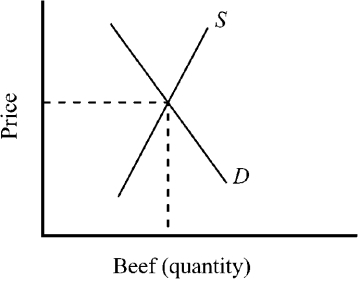 -Figure 3-4 shows conditions in the market for beef. A reduction in the price of the grain used to feed cattle results in
-Figure 3-4 shows conditions in the market for beef. A reduction in the price of the grain used to feed cattle results in
A) the supply curve for beef shifting to the left resulting in higher beef prices and a lower quantity sold.
B) the supply curve for beef shifting to the right resulting in lower beef prices and a higher quantity sold.
C) the demand curve for beef shifting to the left resulting in lower beef prices and a lower quantity sold.
D) the demand curve for beef shifting to the right resulting in higher beef prices and a higher quantity sold.
F) A) and B)
Correct Answer

verified
Correct Answer
verified
Multiple Choice
In a typical college town, when students go home for the summer, the demand for many items such as pizza and textbooks
A) decreases, which is a shift to the left of the demand curves for these goods.
B) decreases, which is a shift to the right of the demand curves for these goods.
C) increases, which is a shift to the left of the demand curves for these goods.
D) increases, which is a shift to the right of the demand curves for these goods.
F) A) and B)
Correct Answer

verified
Correct Answer
verified
Multiple Choice
Price is important in a market economy because it
A) eliminates imbalances between supply and demand.
B) serves as the rationing mechanism for the limited supplies of goods and services.
C) coordinates the choices of consumers and producers and brings them into harmony.
D) is all of the above.
F) A) and C)
Correct Answer

verified
Correct Answer
verified
Multiple Choice
Suppose demand decreases and supply increases. Which of the following will happen?
A) Equilibrium price will rise, fall, or stay the same while equilibrium quantity will decrease.
B) Equilibrium price will rise, fall, or stay the same while equilibrium quantity will increase.
C) Equilibrium quantity will rise, fall, or stay the same and equilibrium price will increase.
D) Equilibrium quantity will rise, fall, or stay the same while equilibrium price will decrease.
E) The change in equilibrium price and quantity cannot be determined.
G) A) and E)
Correct Answer

verified
Correct Answer
verified
Multiple Choice
If Georgia experiences a late frost that damages the peach crop, we should expect the
A) supply curve for peaches to shift to the right and the price of peaches to fall.
B) supply curve for peaches to shift to the left and the price of peaches to rise.
C) demand curve for peaches to shift to the left and the price of peaches to fall.
D) demand curve for peaches to shift to the right and the price of peaches to rise.
F) B) and D)
Correct Answer

verified
Correct Answer
verified
Multiple Choice
If we observe an increase in the price of a good and a decrease in the amount of the good bought and sold, this could be explained by
A) an increase in the supply of the good.
B) an increase in the demand for the good.
C) a decrease in the demand for the good.
D) a decrease in the supply of the good.
F) All of the above
Correct Answer

verified
Correct Answer
verified
Multiple Choice
Graphically, what impact would an increase in the price of jet fuel have on the market for air travel?
A) It would shift the supply curve for air travel to the right.
B) It would shift the supply curve for air travel to the left.
C) It would shift the demand curve for air travel to the right.
D) It would shift the demand curve for air travel to the left.
F) A) and D)
Correct Answer

verified
Correct Answer
verified
Multiple Choice
If a small percentage increase in the price of a good results in a rather large percentage increase in the quantity supplied of the good, supply is said to be
A) vertical.
B) relatively inelastic.
C) relatively elastic.
D) robust.
F) A) and C)
Correct Answer

verified
Correct Answer
verified
Multiple Choice
The maximum price that consumers are willing to pay for the hundredth unit of a good can be found as
A) the height of the supply curve at a quantity of 100.
B) the height of the demand curve at a quantity of 100.
C) the difference between the height of the supply and demand curves at a quantity of 100.
D) none of the above.
F) A) and B)
Correct Answer

verified
Correct Answer
verified
Showing 161 - 180 of 336
Related Exams